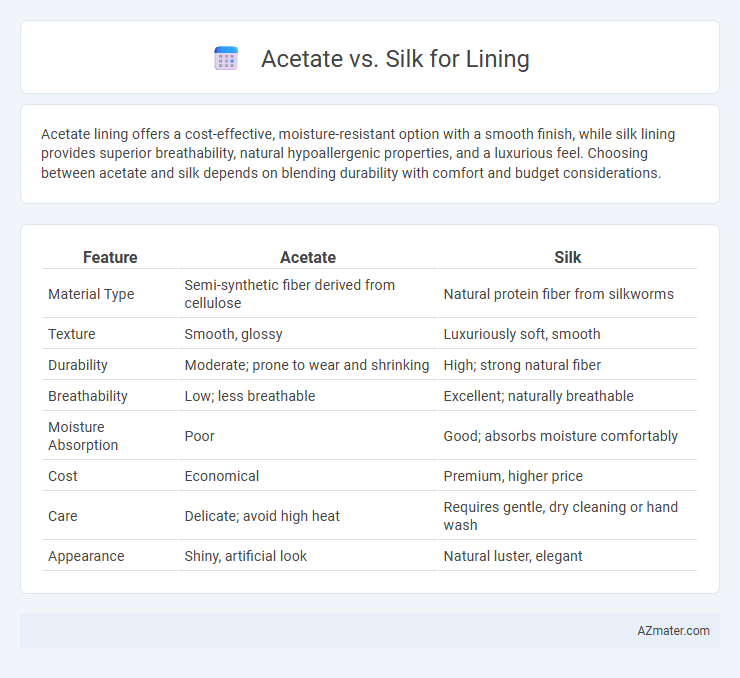Acetate lining offers a cost-effective, moisture-resistant option with a smooth finish, while silk lining provides superior breathability, natural hypoallergenic properties, and a luxurious feel. Choosing between acetate and silk depends on blending durability with comfort and budget considerations.
Table of Comparison
| Feature | Acetate | Silk |
|---|---|---|
| Material Type | Semi-synthetic fiber derived from cellulose | Natural protein fiber from silkworms |
| Texture | Smooth, glossy | Luxuriously soft, smooth |
| Durability | Moderate; prone to wear and shrinking | High; strong natural fiber |
| Breathability | Low; less breathable | Excellent; naturally breathable |
| Moisture Absorption | Poor | Good; absorbs moisture comfortably |
| Cost | Economical | Premium, higher price |
| Care | Delicate; avoid high heat | Requires gentle, dry cleaning or hand wash |
| Appearance | Shiny, artificial look | Natural luster, elegant |
Introduction to Fabric Linings
Acetate and silk are popular fabric linings used in apparel and accessories, each offering unique characteristics suited for different purposes. Acetate linings are valued for their smooth, glossy finish and affordability, making them ideal for adding a luxurious feel to garments without a high cost. Silk linings provide superior breathability, natural moisture-wicking properties, and a soft, elegant touch, often preferred in high-end fashion for their comfort and durability.
What is Acetate Lining?
Acetate lining is a synthetic fabric commonly used in garments for its smooth texture and lustrous finish, providing a comfortable inner layer in jackets, coats, and dresses. It is derived from cellulose fibers, making it lightweight, breathable, and resistant to static cling, which helps maintain the garment's shape and feel. Compared to silk, acetate is more affordable and easy to care for but may lack the natural breathability and durability that silk offers as a luxurious lining material.
What is Silk Lining?
Silk lining is a natural fiber fabric derived from the cocoons of silkworms, known for its smooth texture, breathability, and moisture-wicking properties, making it ideal for garment linings. Compared to acetate, which is a synthetic fiber often chosen for its affordability and sheen, silk offers superior durability, hypoallergenic qualities, and temperature regulation. The luxurious feel and natural composition of silk lining enhance comfort, especially in high-end tailoring and delicate fabrics.
Comparing Texture and Feel
Acetate linings offer a smooth, cool feel with a slight sheen, making garments feel lightweight and comfortable against the skin. Silk linings provide a luxuriously soft, natural texture that is breathable and gentle, ideal for high-end, sensitive skin applications. While acetate is more affordable and durable, silk excels in moisture-wicking and temperature regulation, delivering superior comfort and elegance.
Breathability and Comfort
Acetate linings offer moderate breathability due to their synthetic origin, making them suitable for lightweight garments but less effective at moisture-wicking compared to natural fibers. Silk linings excel in breathability and comfort by allowing air circulation and effectively regulating temperature, providing a smooth, hypoallergenic feel against the skin. Choosing silk enhances comfort in warm climates, while acetate may be preferred for budget-friendly or less delicate apparel linings.
Durability and Longevity
Acetate linings offer moderate durability, providing a smooth and breathable feel but tend to wear out faster due to lower resistance to friction and moisture. Silk linings deliver superior longevity with natural resilience, maintaining their strength and appearance over time while offering excellent breathability and comfort. Choosing silk enhances the lifespan of garments, especially for high-quality suits and jackets frequently worn or dry-cleaned.
Cost Comparison: Acetate vs Silk
Acetate linings are significantly more cost-effective than silk, with acetate priced approximately 70-80% lower per yard, making it ideal for budget-conscious garment production. Silk, known for its luxurious feel and superior breathability, commands a premium price due to its natural fibers and labor-intensive manufacturing process. While acetate offers affordability and decent performance, silk's higher cost reflects its durability, sheen, and comfort, influencing lining choices in high-end versus mass-market apparel.
Maintenance and Care Requirements
Acetate linings require gentle washing with mild detergent and should be air-dried to prevent damage, while silk linings demand even more delicate handling, often requiring professional dry cleaning to maintain their natural sheen and texture. Acetate's moisture sensitivity means it can lose shape if exposed to excessive water, whereas silk is prone to shrinking and fading without proper care. Both fabrics benefit from storing garments in cool, dry environments to extend their lifespan and preserve fabric integrity.
Environmental Impact and Sustainability
Acetate linings, derived from wood pulp and cellulose, offer partial biodegradability but involve chemical-intensive production processes contributing to environmental pollution. Silk linings, produced from silkworm cocoons, are a natural, renewable resource with minimal ecological footprint and excellent biodegradability, supporting sustainable fashion practices. Choosing silk over acetate enhances garment sustainability by reducing reliance on synthetic chemicals and promoting biodegradable fabric waste.
Best Uses: When to Choose Acetate or Silk
Acetate linings are best suited for affordable garments, offering a smooth finish and good moisture absorption, ideal for lightweight suits and dresses. Silk linings provide superior breathability, luxurious feel, and natural temperature regulation, making them perfect for high-end or formal wear and delicate fabrics. Choose acetate for cost-effective, durable linings; select silk for premium quality, comfort, and elegance in tailored clothing.

Infographic: Acetate vs Silk for Lining
 azmater.com
azmater.com